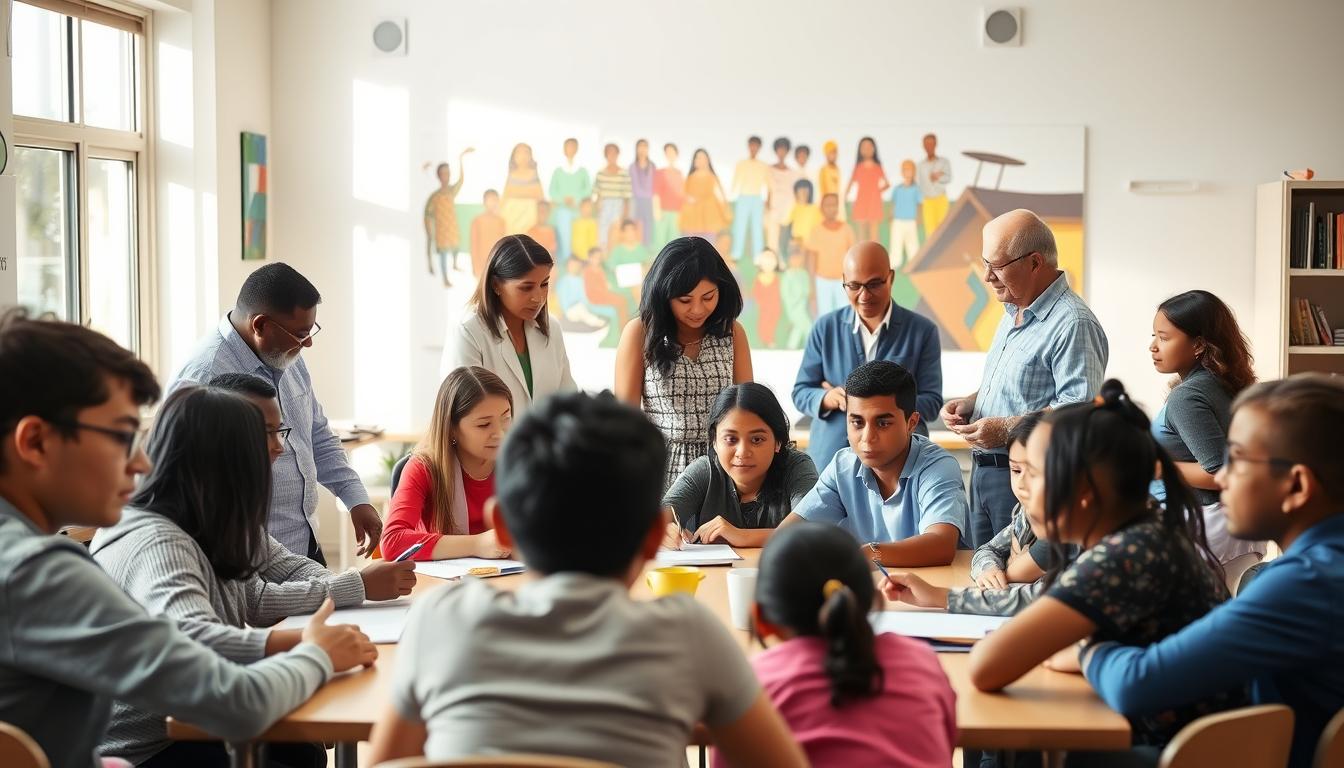Expanding STEM Opportunities: Access for Immigrant Students in Science and Technology
The education landscape in the United States is changing. It brings both challenges and chances, especially in science and technology. Immigrant students are a key part of this change. They can greatly help in these fields. But, they face many obstacles on their STEM education path.
It’s crucial to open more STEM doors for these students. This will help bring new ideas and diversity to the workforce.
This article looks into the hurdles immigrant students meet when trying to get into STEM. We’ll also check out programs that help make STEM education fair for all. The goal is to make sure every student has a chance to succeed in science and technology. We want to encourage everyone to work together to make STEM opportunities better for immigrant students. This way, their voices will be heard and valued in education.
Understanding STEM and Its Importance
STEM stands for science, technology, engineering, and mathematics. These areas are key for innovation and economic growth. Knowing how important STEM is helps us understand today’s fast-changing world.
Definition of STEM Fields
STEM fields cover many areas of study and work. They include biology, physics, computer science, engineering, and math. This mix of disciplines encourages teamwork and creativity, helping solve complex problems.
Impact of STEM on Society
STEM education has a big impact on society. It gives people the skills to innovate and solve problems. A strong STEM education helps the economy by creating a skilled workforce.
This workforce can tackle big challenges like climate change and healthcare. More people in STEM means more diverse solutions.
Current Trends in STEM Education
STEM’s importance is growing, leading to new trends in education. Schools are using technology, project-based learning, and teamwork. These methods make learning more engaging and prepare students for the real world.
By focusing on teamwork, STEM education is making students ready for the future.
Challenges Faced by Immigrant Students in STEM
Immigrant students face many challenges in STEM education. It’s important to understand these obstacles to create a welcoming environment. Issues include language barriers, cultural differences, and limited resources.
Language Barriers
Many immigrant students struggle with language barriers in STEM classes. These barriers make it hard for them to communicate with teachers. Struggles with technical vocabulary and subject-specific jargon can lead to frustration and lower grades.
Cultural Differences
Immigrant students also deal with cultural differences in school. Different learning styles and classroom expectations can make them feel isolated. It’s crucial to respect and understand these cultural backgrounds to help them succeed.
Resource Limitations
Another big challenge is the lack of resources for immigrant students in STEM. They often don’t have access to technology and financial help. This scarcity can limit their educational goals and career chances.
Government Initiatives to Support STEM Access
Government support is key in helping immigrant students in STEM fields. Many initiatives focus on federal programs, state efforts, and community support. These help make STEM education more accessible.
Federal Programs
The National Science Foundation (NSF) is a big help in STEM education. It provides funding and grants. These help improve teaching and get students more interested in science and technology.
State-Level Initiatives
States have their own STEM programs. They offer scholarships and special programs. These help immigrant students get into STEM fields.
Community-Based Support Systems
Community groups are vital for immigrant students. They offer tutoring, mentorship, and networking. This support helps students reach their STEM goals.
Nonprofit Organizations Promoting STEM Opportunities
Nonprofit groups are key in making science, technology, engineering, and math (STEM) accessible to immigrant students. They work hard to bring diversity and inclusion to these important fields. Their programs help underrepresented groups succeed, setting a good example for the future.
Notable Programs and Their Impacts
Groups like the Society of Hispanic Professional Engineers (SHPE) and Girls Who Code are making a big difference. SHPE helps Hispanic students with mentorship, scholarships, and projects. Girls Who Code aims to close the gender gap in tech by teaching coding to girls.
Both show how focused efforts can lead to success in STEM fields.
Partnerships with Schools
Working together, nonprofits and schools can do more. Schools get special training and chances for students to network. This partnership boosts the impact of nonprofit work and changes how STEM is taught.
Case Studies of Success
Many stories show how nonprofits help immigrant students in STEM. For example, SHPE’s mentorship boosts students’ confidence and dreams. Girls Who Code alumni have made it big in tech, proving early support pays off.
These stories prove nonprofits are making a real difference in STEM education.
The Role of Schools in Facilitating STEM Learning
Schools are key in growing student interest and success in STEM fields. They create inclusive STEM curriculums to meet all students’ needs. This helps everyone do well, especially immigrant students who might find STEM subjects hard.
Clubs and science fairs are important outside the classroom. They let students use what they learn in real life. These activities also help students work together and solve problems, skills needed for STEM jobs.
Teachers need training to teach STEM well. They learn how to teach immigrant students and meet their learning needs. This makes learning better for everyone, creating a supportive STEM education environment.
Technology as a Tool for Inclusion in STEM
Technology is key in making STEM education more accessible for immigrant students. It lets learners study at their own pace, breaking down old barriers. Sites like Khan Academy and Coursera offer free knowledge, helping students learn when they want.
Online Learning Platforms
Online learning platforms are changing STEM education. They provide a wide range of courses, from basics to advanced topics. This is great for those with busy schedules.
These platforms use videos and interactive exercises. They help different learning styles, making education more welcoming.
Interactive Tools and Resources
Interactive tools make learning fun and engaging. They use games and simulations to explain complex ideas. This approach improves understanding and encourages teamwork.
It also makes STEM subjects more appealing, reducing fear and intimidation.
Accessibility Features in STEM Technology
Inclusive technology helps all students, no matter their abilities or backgrounds. Tools like language translators and assistive technology support a wide range of learners. They create a supportive learning space.
These features are crucial for immigrant students to succeed in STEM. They help educators build an inclusive classroom.
Encouraging Diversity in STEM Fields
Diversity in STEM fields is key to innovation and teamwork. It brings different views, leading to better problem-solving and creativity. Including everyone in STEM education and jobs helps both individuals and society.
Importance of Representation
Having diverse teams in tech is crucial. It makes everyone feel valued and able to contribute. This diversity leads to better technology and solutions.
It also creates a culture of inclusiveness. This inspires more people to get into STEM.
Strategies for Inclusive Recruitment
It’s important to attract people from all backgrounds. Schools and companies can use several strategies:
- Outreach programs targeting underrepresented communities
- Internships that emphasize diverse candidate pools
- Partnerships with local organizations to promote STEM opportunities
These methods make STEM education and jobs available to all. This enriches the field.
Success Stories from Diverse Backgrounds
Stories of success from diverse backgrounds show the power of inclusion. They inspire others to reach for their dreams in STEM. These stories remind us of the amazing things diversity can achieve.
Scholarships and Financial Aid for Immigrant Students
Getting financial help is key for immigrant students aiming for STEM careers. Many scholarships and aid programs are out there to help. They aim to break down funding barriers for education. This way, they support diversity in STEM fields.
Overview of Available Scholarships
There are many STEM scholarships for immigrant students. These include:
- The Gates Millennium Scholars Program
- Society of Hispanic Professional Engineers (SHPE) Scholarships
- Asian Pacific Islander American Scholarship Fund
These scholarships cater to different groups and fields. This means more students can get the funding they need.
How to Apply for Financial Aid
Applying for financial aid needs careful steps. Here’s what to do:
- Complete the Free Application for Federal Student Aid (FAFSA)
- Gather needed documents like transcripts and income records
- Look up specific scholarship rules and meet deadlines
Being well-organized and active in applying boosts your chances of getting funding.
Importance of Financial Support in STEM Education
Financial aid is crucial for immigrant students in STEM. Without it, many talented students face big hurdles. Scholarships help by easing financial stress and boosting motivation.
By providing enough financial aid, we ensure a diverse and innovative future in tech and science.
Community Engagement and Mentorship Programs
Community programs and mentorship are key for immigrant students in STEM fields. They help students connect with professionals who guide and inspire them. These connections are vital for success in STEM.
Building Local Mentorship Networks
Creating local mentorship networks is the first step in effective STEM mentorship. These networks connect students with industry experts. Mentors offer advice, share experiences, and boost students’ confidence.
Volunteering and Community Service
Volunteering lets students use their STEM skills to help their communities. It makes learning more meaningful and helps students feel part of their community. Through volunteering, they improve their skills and grow their networks.
Impact of Mentorship on Student Growth
Studies show mentorship greatly benefits students. Mentored students do better in school, are more motivated, and feel more capable. Mentorship in STEM prepares students for future challenges and opportunities in science and technology.
Workforce Development and Internships
In today’s job market, getting ready for STEM careers is key. STEM internships are a big help for immigrant students. They bridge the gap between school and work, giving them skills employers want.
Opportunities for Immigrant Students
Many tech firms and organizations now offer STEM internships for immigrant students. These programs give them the skills and experience needed to succeed. Students can use these internships to make their resumes stand out and connect with their field.
Importance of Real-World Experience
Getting real-world STEM experience makes students stand out. It teaches them to apply what they learn in class. This hands-on learning boosts their confidence and prepares them for career challenges.
Partnering with Tech Companies
Working together, schools and tech companies can make a big difference. They can create internships that meet both educational and industry needs. This partnership helps immigrant students show their skills and helps companies find new ideas.
Future Trends in STEM Opportunities for Immigrants
The world of STEM is changing fast, offering great chances for immigrant students. They can explore new fields in science, technology, engineering, and mathematics. These areas are growing and innovating, meeting new needs and advancing technology.
Emerging Fields and Career Paths
New careers are popping up in fields like artificial intelligence, renewable energy, and biotechnology. Immigrant students can enter these fields with the right skills. The need for data science and cybersecurity experts shows STEM’s future needs a skilled, diverse workforce.
Predictions for STEM Education
Education is moving towards personalized learning and online platforms. This means students will get learning experiences that fit them better. For immigrant students, this could open doors to STEM careers.
Long-term Impact on the Workforce
The impact of these changes is huge. A diverse STEM workforce will lead to more innovation and growth. Companies see the value in a diverse team for creativity and solving problems. Immigrants will be key in shaping STEM’s future and tackling global issues.
Conclusion: The Path Forward for STEM Equity
To achieve STEM equity for immigrant students, we need ongoing support. Federal, state, and community backing is key to open STEM education doors. When educators, groups, and leaders join forces, they help immigrant students succeed in science and tech.
Collaborative Efforts Needed
Stakeholders must work together for real change. They should create programs that tackle immigrant students’ special challenges. Partnerships between schools, nonprofits, and businesses are crucial for a diverse STEM talent pipeline.
Call to Action for Stakeholders
Everyone must support initiatives for a diverse STEM future. Offering scholarships, mentorship, and resources is essential. This teamwork not only improves education but also builds a diverse, innovative workforce.
Envisioning a Diverse STEM Future
Seeing a diverse STEM future means valuing different views. Immigrant students bring new ideas and solutions. The journey ahead needs commitment, inclusivity, and a shared goal for a diverse, equitable future.
FAQ
What STEM opportunities are available for immigrant students?
How can immigrant students apply for STEM scholarships?
Are there internships specifically aimed at immigrant students in STEM?
What challenges do immigrant students face in pursuing STEM education?
How do nonprofit organizations contribute to STEM education for immigrant students?
What role do schools play in facilitating STEM learning for immigrant students?
How is technology being used to improve STEM access for immigrant students?
Why is diversity important in STEM fields?
What are some strategies to encourage immigrant students to pursue STEM careers?
How can students benefit from mentorship programs in STEM?
What are the emerging trends in STEM opportunities for immigrant students?
Published on: 28 de March de 2025

Luke Martin
Luke Martin, author of Credwallets.com, is a mathematics graduate with a specialization in financial markets. Known for his love of pets and his passion for sharing knowledge, Luke created the site to provide valuable insights into the complexities of the financial world. His approachable style and dedication to helping others make informed financial decisions make his work accessible to all, whether they're new to finance or seasoned investors.







